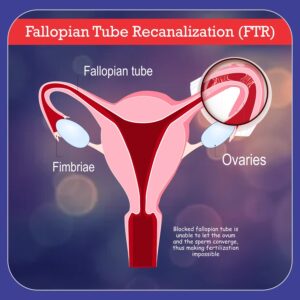FTR: Minimally Invasive Treatment for Tubal Blockage & Infertility
Infertility is a challenge many women face worldwide, and one of the most common causes is blockage of the fallopian tubes. These tubes play a vital role in natural conception by allowing the egg to travel from the ovary to the uterus where fertilization occurs. When a fallopian tube is blocked or narrowed, it can prevent pregnancy and cause significant emotional distress.
Fortunately, advances in interventional radiology have made it possible to address certain tubal blockages through a minimally invasive procedure called Fallopian Tube Recanalization (FTR). This outpatient technique offers an effective alternative to surgery, enabling many women to restore their fertility naturally.
Dr. Anusha Bingi, a leading interventional radiologist in Hyderabad, specializes in this innovative procedure, offering expert care using state-of-the-art imaging technology. If you are struggling with infertility due to tubal blockage, FTR might be the ideal treatment option for you.

What Is Fallopian Tube Recanalization (FTR)?
Fallopian Tube Recanalization is a minimally invasive, image-guided procedure designed to open blocked fallopian tubes, restoring their natural function and improving the chances of pregnancy.
During FTR, Dr. Anusha Bingi uses fluoroscopic (real-time X-ray) guidance to carefully thread a very thin catheter through the cervix into the uterus, and then into the affected fallopian tube. Using a specialized guidewire, the blockage is gently cleared, allowing eggs to pass through the tube once again.
This modern approach has made fallopian tube recanalization in Hyderabad an increasingly preferred fertility treatment for eligible women.
Get Expert Insights
Who Is an Ideal Candidate for FTR?
FTR is especially effective for proximal tubal blockages — blockages located near the uterus. Women who may benefit from this procedure include:
- Those diagnosed with proximal tubal obstruction confirmed by imaging
- Patients seeking a non-surgical fertility restoration method
- Women who have experienced recurrent infertility despite other treatments
- Patients wishing to avoid the risks and recovery time of surgery
Before recommending FTR, Dr. Anusha Bingi thoroughly evaluates each patient’s medical history, imaging results, and fertility goals to determine if this treatment is appropriate.
How Is Fallopian Tube Recanalization Performed?
How Is Fallopian Tube Recanalization Performed?
The FTR procedure in Hyderabad is done as a day-care procedure. It typically takes 30 to 60 minutes and is performed under local anesthesia.
- Preparation: Patients are positioned comfortably, and local anesthesia is applied to minimize discomfort. Mild sedation may also be administered if needed.
- Catheterization: A thin catheter is introduced through the cervix into the uterine cavity.
- Navigating the Fallopian Tube: Using real-time fluoroscopic imaging, Dr. Bingi guides the catheter into the blocked fallopian tube.
- Clearing the Blockage: A tiny guidewire or balloon may be used to gently open or dilate the obstruction.
- Verification: Contrast dye is injected to confirm the tubes are open and allowing fluid to pass freely.
- Completion: The catheter is removed, and the patient is monitored briefly before discharge.
Because the procedure is minimally invasive, most patients can go home the same day.
Benefits of Choosing Fallopian Tube Recanalization
Fallopian Tube Recanalization offers several advantages over surgical alternatives:
- Minimally invasive: No large incisions or hospital stays required
- Quick recovery: Most patients resume normal activities within 24 to 48 hours
- Preserves natural fertility: No disruption of ovarian or uterine function
- High success rates: Especially effective for proximal tubal obstructions
- Less expensive and lower risk: Compared to laparoscopic or open surgery
- Improved chances of natural conception: Without the need for assisted reproductive technologies
Many patients report natural conception within months of undergoing the procedure. It’s a highly successful method for women seeking to conceive naturally, especially when performed by a FTR specialist in Hyderabad like Dr. Anusha Bingi.
What to Expect After the Procedure
Following FTR, mild cramping or spotting may occur but generally resolves quickly. Patients are encouraged to rest for the remainder of the day and avoid strenuous activities for a short period.
Post-procedure care includes:
- Monitoring for any signs of infection or unusual symptoms
- Follow-up ultrasounds or HSG to assess tubal patency
- Guidance on timing intercourse to maximize chances of conception
Most women can expect to attempt natural pregnancy within the first few menstrual cycles after treatment.
Why Choose Dr. Anusha Bingi for Your Fallopian Tube Recanalization?
Dr. Anusha Bingi combines extensive training in interventional radiology with a compassionate approach to patient care. Her focus is on delivering minimally invasive, effective solutions tailored to individual needs.
Patients who choose Dr. Anusha Bingi benefit from:
- Personalized treatment plans based on comprehensive diagnostics
- Expertise in catheter-based fertility-restoring procedures
- Access to cutting-edge fluoroscopy and imaging technologies
- Supportive care from initial consultation through recovery and beyond
Whether you’re dealing with unexplained infertility or confirmed tubal blockage, she is recognized as one of the best doctors for fallopian tube recanalization in Hyderabad.
Take the Next Step Toward Your Fertility Goals
Blocked fallopian tubes don’t have to mean the end of your fertility hopes. With Fallopian Tube Recanalization, women now have access to a gentle, highly effective solution that restores reproductive potential without the need for surgery.
To explore whether FTR is right for you, schedule a consultation with Dr. Anusha Bingi, interventional radiologist. Her patient-centered approach and state-of-the-art techniques can help you take the next confident step toward starting or expanding your family.
